 |
PO Box 9021,
Wilmington, DE 19809, USA
E-mail: font@focusonnature.com
Phone: Toll-free in USA 1-888-721-3555
or 302/529-1876 |
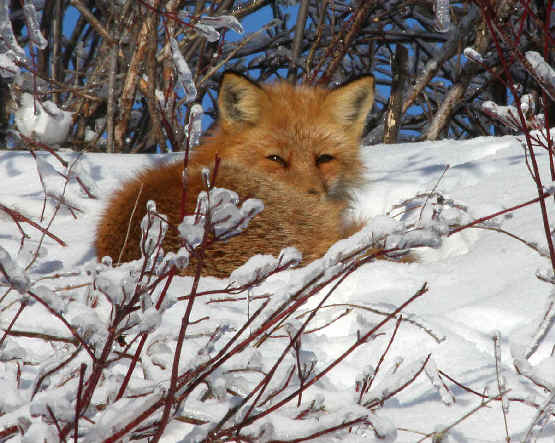 MAMMALS
MAMMALS
in
Eastern
North America
Noting those during
Focus On Nature Tours
with an (*)
including those during
our tours
in Florida, Newfoundland,
the Delmarva Peninsula,
and North Carolina
1992 thru 2015
List compiled by Armas Hill
Photo at
Upper Right:
a RED FOX
(photograph by Doris Potter)
Codes:
(i): introduced species
(p): seen during offshore pelagic trip
(ph): species with a photo in the FONT website
DE: occurs in Delaware
FL: occurs in Florida
MD: occurs in Maryland
NC: occurs in North Carolina
NJ: occurs in New Jersey
PA: occurs in Pennsylvania
VA: occurs in Virginia
Links to Groupings in this List:
LAND MAMMALS
Opossum & Armadillo
Shrews & Moles Rabbits
Porcupine
Some Aquatic Mammals
(Nutria, Beaver,
Muskrat) Woodchuck & Squirrels
Rats, Mice, and the like
Bats Cats
Dogs Bears
Raccoon & Mustelids
Seals
Deer Manatee
MARINE MAMMALS
Whales, Dolphins, Porpoise
Other Links:
Upcoming
FONT Birding & Nature Tours in North America
Mammals of North America (with some photos)
Birds during Previous FONT North Carolina
Tours (with some photos)
Birds of the Delmarva Peninsula (DE, MD, & VA) (with some
photos)
Butterflies of Eastern North
America
(with some photos)
Moths of Eastern North
America (with some photos)
Dragonflies & Damselflies of Eastern North
America (with some photos)
Amphibians &
Reptiles of Eastern North America (with some
photos)
Wildflowers & Other Plants of Eastern North America (with some
photos)
Directory
of Photos in this Website

A book, published back in 1903, entitled "The Mammals of
Pennsylvania and New Jersey - A Biographic, Historic and Descriptive Account of
the Furred Animals of Land and Sea, both Living and Extinct, known to have
Existed in These States", was written by Samuel H. Rhoads.
References to that historic book are throughout the list that follows.
Land Mammals:
Opossum &
Armadillo
- Virginia Opossum (ph) ______
DE(*) FL MD(*) NC(*) NJ PA
VA
Didelphis virginiana
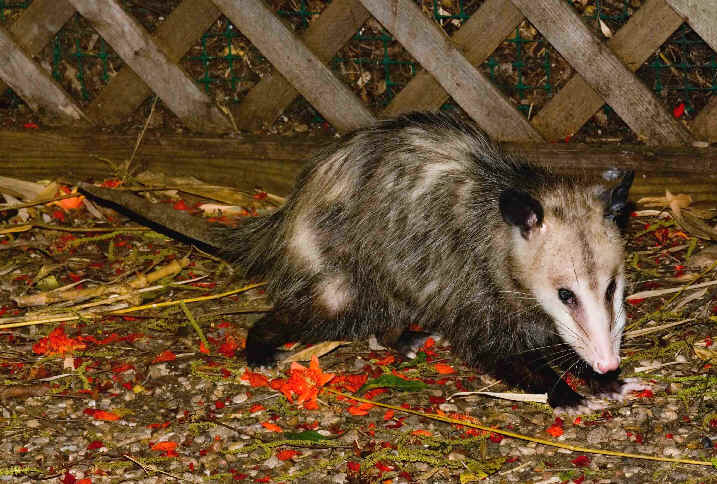
A Virginia Opossum photographed during a FONT tour
(photo by Karl Frajford)
Nine-banded Armadillo (ph) ______ FL(*)
Dasypus novemcinctus
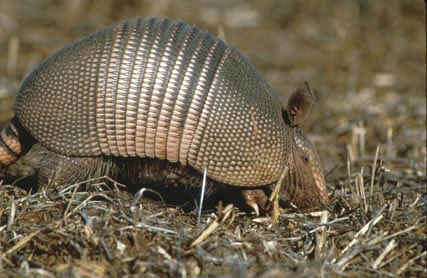
Nine-banded Armadillo
Shrews
Cinereous Shrew ______ DE
MD
NJ
PA VA
(was called the Masked Shrew)
Sorex cinereus
Sorex cinereus nigriculus Tuckahoe Shrew ______
NJ
This species and the following, called the Eastern Masked Shrew,
Sorex personnatus, by Rhoads in 1903.
Southeastern Shrew ______ MD
NC VA
(was conspecific with Sorex cinereus,
the former Masked Shrew)
Sorex longirostris
Referring to the above 2 animals as one species, Rhoads (in 1903)
wrote the following:
"This the least of our mammals, and being subterranean in its
living and rare in upland tracts, it is seldom seen alive."
Nor was it alive in the photo below, taken by
Alan Brady in 1998, at Pickering Beach in Delaware, where the animal was
found. With the shrew in the photo is a US cent.
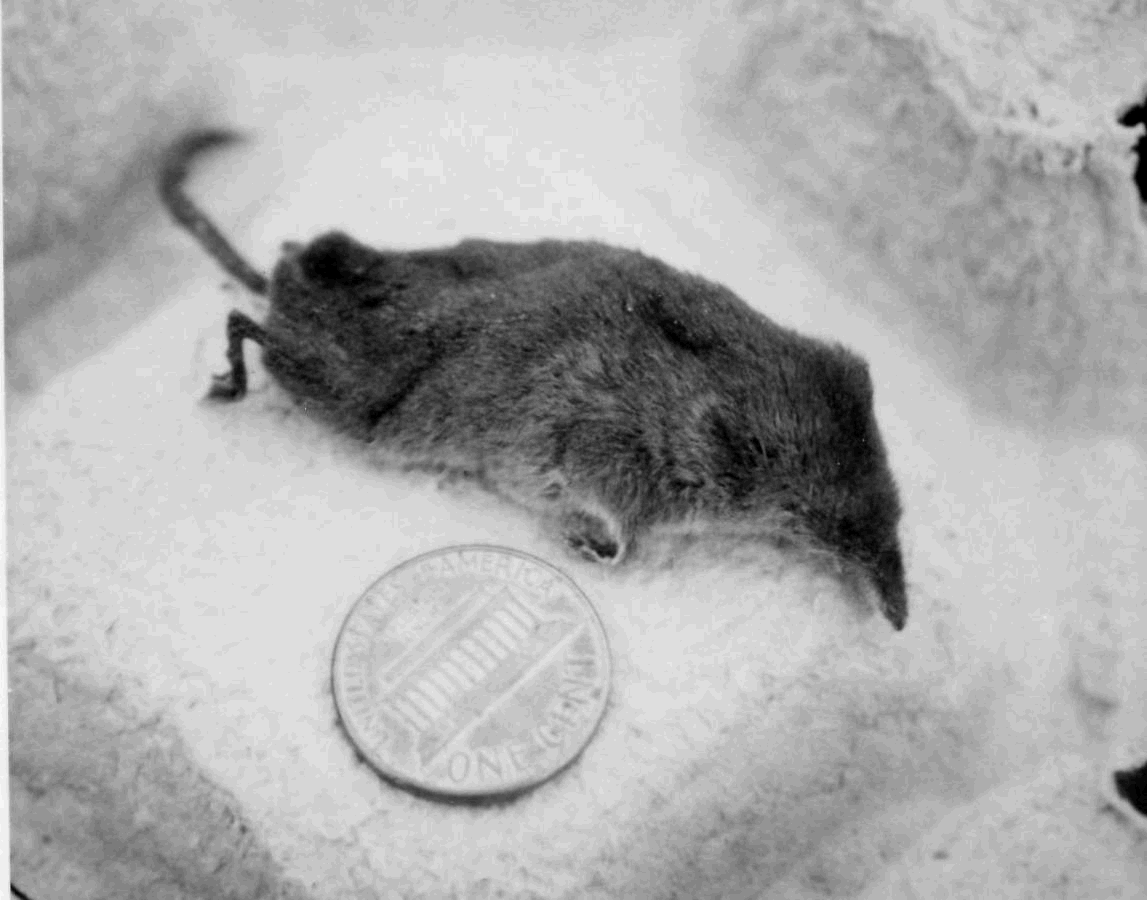
Southeastern Shrew
Pygmy Shrew ______ NC
NJ
PA
Sorex hoyi
Sorex hoyi winnemane Southern Pygmy Shrew
______ MD(rare)
Long-tailed Shrew ______
MD(rare) NC NJ PA
(another name is Rock Shrew)
Sorex dispar
Sorex dispar
occurs in Appalachian uplands.
Smoky Shrew ______ MD(rare)
NC NJ PA
Sorex fumeus
Gaspe Shrew ______
Sorex gaspensis
Water Shrew ______ NJ
PA
Sorex palustris
Sorex palustris punctulatus Southern Water Shrew
______ MD(very
rare)
Called the Eastern Marsh Shrew, or Big Water Shrew,
by Rhoads in 1903.
Arctic Shrew ______
Sorex arcticus maritimensis
Least Shrew ______ DE
MD
NC NJ PA(rare)
Cryptotis parva
Called the Least Mole Shrew by Rhoads in 1903.
Cryptotis parva is classified as
endangered in Pennsylvania.
Northern Short-tailed Shrew ______
DE NC NJ PA
Blarina brevicauda
Called the Large Bob-tail Shrew, or North Eastern Mole
Shrew, by Rhoads in 1903.
Southern Short-tailed Shrew ______ NC
Blarina carolinensis
Eastern Mole ______
DE MD NC NJ PA
Scalopus aquaticus
Called the Eastern Naked-tail Mole by Rhoads in 1903. This
species was described by Linnaeus in 1758.
Hairy-tailed Mole ______ MD
NC NJ PA
Parascalops breweri
Called the Eastern Hairy-tailed Mole, or Brewer's Mole,
by Rhoads in 1903.
Star-nosed Mole ______ DE
MD
NC NJ PA
Condylura cristata
Also called the Long-tailed, or Swamp Mole by
Rhoads in 1903. The species was described by Linnaeus in
1758.
Rabbits
Eastern Cottontail (ph) ______
DE(*) MD(*) NC(*) NJ PA VA
Sylvilagus floridannus
Called the Southeastern, or Lowland
Cottontail, or Rabbit, by Rhoads in 1903.
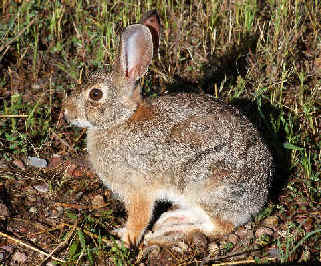
Eastern Cottontail
(photo by Doris Potter)
Appalachian Cottontail ______ MD(very
rare) NC
Sylvilagus obscurus
Called the Alleghenian Cottontail, or Rabbit by Rhoads in
1903, with the now historic scientific name Lepus
floridanus transitionalis.
New England Cottontail ______ NJ(rare)
PA(rare)
Sylvilagus transitionalis
Marsh Rabbit ______ NC(*)
Sylvilagus palistris
Snowshoe Hare ______ MD(extirpated)
PA(rare)
Lepus americanus
Referred to as the Alleghenian Varying Hare, or "White
Rabbit", Lepus amerianus virgininianus,
by Rhoads in 1903.
Arctic Hare ______ NF
Lepus arcticus
Cape Hare (i) ______
Lepus capensis
Porcupine
North American Porcupine (ph)
______ MD(very
rare) NJ PA
Erethizon dorsatum
Called the Canada Porcupine, or "Hedgehog", by
Rhoads in 1903. The species was described by Linnaeus in 1758.
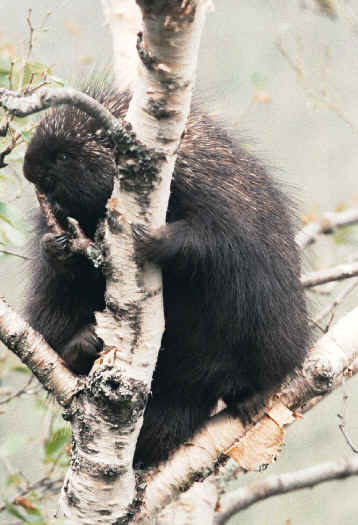
North American Porcupine
(photo by Doris Potter)
Some Aquatic
Mammals
Nutria (i) (ph) ______
MD NC(*) NJ
Myocastor coypus
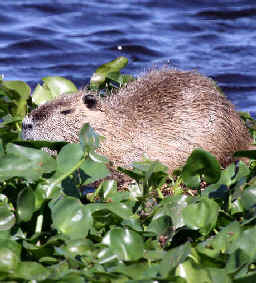
A Nutria photographed during a FONT tour
(photo by Marie Gardner)
American Beaver (ph) ______
DE(*) MD NC NJ PA
Castor canadensis
Called the Northeastern, or Canada, Beaver
by Rhoads in 1903, when also noted was the Southeastern Beaver, Castor
canadensis carolinensis.
The American Beaver has been re-introduced in
Pennsylvania.
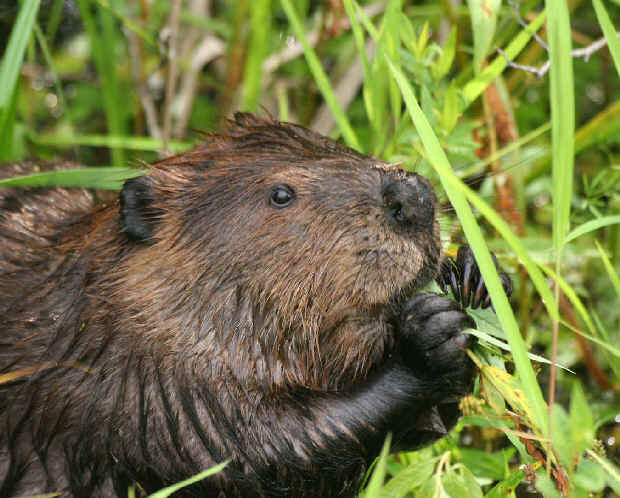
American Beaver
(photo by
Doris Potter)
Muskrat (ph) ______ DE(*)
MD
NC NJ PA VA
Ondatra zibethicus
Referred to by Rhoads in 1903 as the Southeastern Muskrat, with
the scientific name Fiber zibethicus.
The species was described by Linnaeus in 1766.
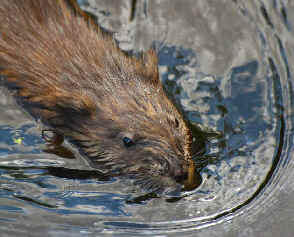
Muskrat
(photo by Doris Potter)
Round-tailed Muskrat ______
FL
Neofiber alleni
Woodchuck &
Squirrels
Woodchuck (ph) ______
DE(*) MD NC NJ PA VA
Marmota monax
Called the Groundhog by Rhoads in 1903, when he also noted both
the Southeastern Woodchuck, then Arctomys
monax, and the Northeastern
Woodchuck, then Arctomys monax canadensis.
The species was described by Linnaeus in 1758.
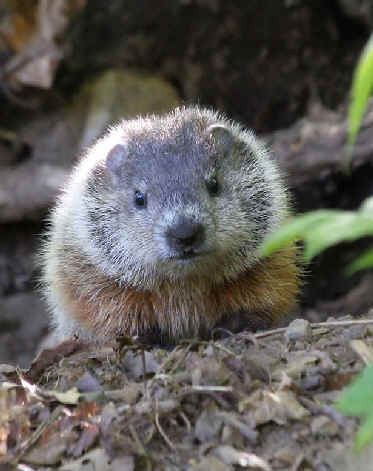
Above: A young Woodchuck; Below: 2 of them.
(photos by Doris Potter)
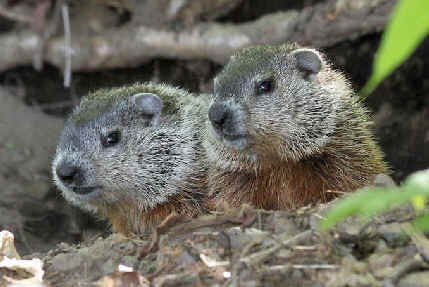
Eastern Gray Squirrel (ph) ______
DE(*) MD(*) NC NJ(*) PA
VA
Sciurus carolinensis
Called the Carolina Gray Squirrel
by Rhoads in 1903, when also noted was the Northern Gray, or Black,
Squirrel, Sciurus carolinensis leucotis.
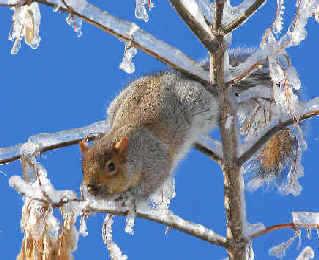
Eastern Gray Squirrel
(photo by Doris Potter)
Eastern Fox Squirrel (ph) ______
NC(*) VA(*) PA
Sciurus niger
Sciurus niger cinereus Delmarva Fox Squirrel
______ DE(very rare) MD(very
rare) PA(probably extirpated) VA(*)
Sciurus niger cinereus is classified as endangered in
Delaware.

An Eastern Fox Squirrel photographed during the FONT North Carolina Tour in
May 2009
(photo courtesy of Cindy & Ron Becker)
Red Squirrel ______ MD
NC NJ PA
Tamiasciurus hudsonicus
Called the Canadian Chickaree, or Pine Squirrel, by Rhoads
in 1903, when also noted was the Southeastern Chickaree, or Red
Squirrel, as Sciurus hudsonicus loquax.
Southern Flying Squirrel ______
DE(*) MD NC NJ PA VA
Glaucomys volans
Called the Virginia Flying Squirrel by Rhoads in 1903. The
species was described by Linnaeus in 1758.
Northern Flying Squirrel ______
NJ PA(rare)
Glaucomys sabrinus
Eastern Chipmunk (ph) ______
DE(*) MD NC NJ PA
Tamias striatus
The Eastern Chipmunk was described by Linnaeus in 1758.
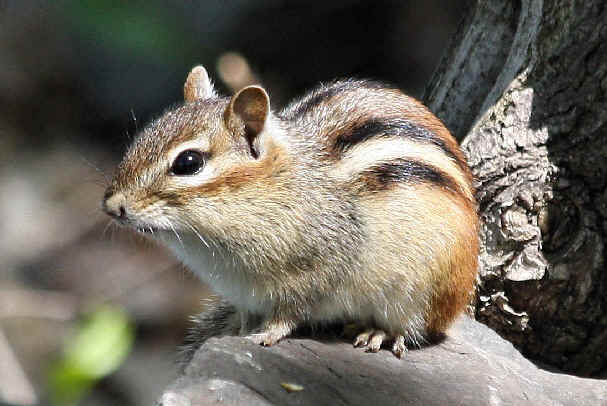
Eastern Chipmunk
(photo by Doris Potter)
Rats, Mice, and
the like
Southeastern Pocket Gopher
______ FL(north)
Geomys pinetis
Eastern Woodrat ______ NC
NJ(very rare)
PA(rare)
Neotoma floridana
Allegheny Woodrat ______ MD(very
rare)
Neotoma magister
Called the Allegheny Cave Rat by Rhoads in 1903, with the
scientific name Neotoma pennsylvanica.
Marsh Rice Rat ______ DE
MD
NC NJ PA(extirpated)
Oryzomys palustris
Called the Northern Rice Rat, or Marsh Rat, by
Rhoads in 1903,
Hispid Cotton Rat (*) ______
NC
Sigmodon hispidus
Woodland Jumping Mouse ______
MD NC NJ PA
Napaeozapus insignis
Called the Miller's Woodland Jumping Mouse by Rhoads in
1903.
Meadow Jumping Mouse ______ DE
MD
NC NJ PA
Zapus hudsonius
Also called the Hudson Bay Zapus by Rhoads in 1903, with
the lowland race being Barton's Zapus, Zapus
hudsonius americanus.
Eastern Harvest Mouse ______ MD
NC
Reithrodontomys humulis
White-footed Deermouse ______ MD
NC NJ PA
Peromyscus leucopus
Called the Rafinesque's Deer Mouse by Rhoads in 1903.
The subspecies Peromyscus leucopus
noveboracensis was then called the Fischer's Deer Mouse.
North American Deermouse ______
MD NC PA
Peromyscus maniculatus
Cotton Deermouse ______ NC
Peromyscus gossypinus
Oldfield Deermouse ______
Peromyscus polionotus
Florida Deermouse ______ FL
Podimys floriddanus
Golden Mouse ______ NC
Ochrotomys nuttalli
Southern Red-backed Vole ______
NJ PA
Clethrionomys gapperi
Called the Gapper's Wood Vole, or Red-back Mouse, by Rhoads in
1903, with then the scientific name Evotomys
gapperi.
The subspecies Evotomys gapperi rhoadsi,
the New Jersey Wood Vole, or Red-back Mouse, was named after
Samuel Rhoads.
Meadow Vole (ph) ______
DE MD NC NJ PA
Microtus pennsylvanicus
Called the Pennsylvania Meadow Vole, or Common Meadow Vole, by
Rhoads in 1903.
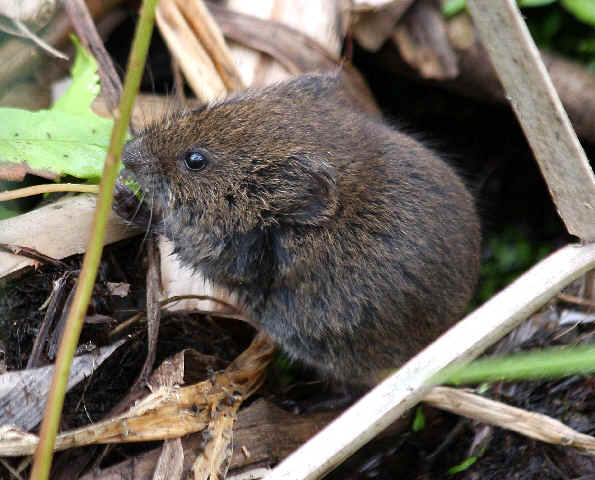
Meadow Vole
(photo by Doris Potter)
Woodland Vole ______
DE MD NC NJ PA (another name is Pine
Vole)
Microtus
(or Pitymys) pinetorum
Called the Northern Pine-woods Vole, or Mole Mouse, by
Rhoads in 1903.
Rock Vole ______ PA(rare)
Microtus chrotorrhinus
Microtus chrotorrhinus carolinensis Southern Rock
Vole ______ MD(very
rare)
Southern Bog Lemming ______ MD
NJ
PA
Synaptomys cooperi
Called the Cooper's Lemming by Rhoads in 1903, when also the
subspecies Synaptomys cooperi stonei,
the Stone's Lemming, was noted.
The "Stone's Lemming" was described in 1893, with the type
locality being May's Landing, in Atlantic County, New Jersey.
Synaptomys cooperi stonei is restricted to higher elevations
in the southern portion of the species' range.
Throughout its range, the Southern Bog Lemming has populations that
are localized and may change with time.
The subspecies in the Dismal Swamp of Virginia/North Carolina, Synaptomys
cooperi helaletes, was recently re-discovered after a hiatus
of 83 years. (1981)
Northern Bog Lemming ______
Synaptomys borealis
Bats
Mexican Free-tailed Bat (ph) ______
NC
Tadarida brasiliensis
Seminole Bat ______ NC(*)
PA(rare)
Lasiurus seminolus
Eastern Red Bat ______
DE MD NC NJ(*) PA
Lasiurus borealis
Called the Northern Red Bat, or Tree Bat, by Rhoads
in 1903.

An Eastern Red Bat, in a tree, during the day
(photo by Alan Brady)
Hoary Bat ______ DE
MD
NC NJ PA
Lasiurus cinereus
Northern Yellow Bat ______
FL NJ(very rare)
Lasiurus intermedius
Silver-haired Bat (ph) ______
DE MD NC NJ(*) PA
Lasionycterius noctivagans
Called the Silvery Black Bat by Rhoads on 1903.
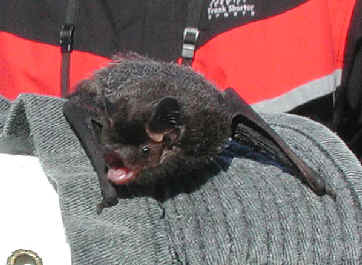
A Silver-haired Bat photographed during a FONT pelagic trip,
on a boat at sea, offshore from New Jersey
Rafinesque's Big-eared Bat ______ NC
Corynorhinus rafinesquii
Northern Myotis ______ MD
NC NJ PA(rare)
(also called Keen's Myotis)
Myotis septentrionalis
Little Brown Myotis ______
DE(*) MD NC NJ PA
Myotis lucifugus
Called the LeContes' Little Brown Bat by Rhoads in 1903.
White-nose Syndrome has recently been a deadly disease in North
America bats, especially the Little Brown Myotis. The disease has
been spreading rapidly since its discovery in 2006 in New York State.
Thus far, bat declines in the northeastern US have exceeded 80 per cent.
Scientists with the U.S. Geological Survey and partner institutions have
identified the cause of White-nose Syndrome as a fungus appropriately
known as Geomyces destructans.
The research has further demonstrated that the fungus can be spread through
contact between individual bats during
hibernation.
Gray Myotis ______ NC
Myotis grisescens
Eastern Small-footed Myotis ______
MD(very rare) NJ
PA(rare)
Myotis leibii
Southeastern Myotis ______ NC
Myotis austroriparius
Indiana Myotis ______ MD(very
rare) NC NJ(very rare) PA(very rare)
Myotis sodalis
Myotis sodalis
is classified as endangered in Pennsylvania.
Eastern Pipistrelle ______
DE(*) MD NC NJ PA
Pipistrellus subflavus
Called the Pigmy Bat by
Rhoads in 1903.
Big Brown Bat ______ DE
MD
NC NJ PA
Eptesicus fuscus
Called the Northeastern Large Brown Bat, or the House Bat,
by Rhoads in 1903.
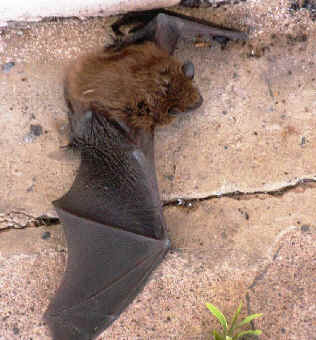
A Big Brown Bat photographed in Delaware in
January 2013
(photo by Marie Gardner)
Evening Bat ______ MD
NC PA(rare)
Nycticeius humeralis
Called the Rafinesque's Little Brown Bat by Rhoads in 1903.
Cats
Bobcat (ph) ______ MD
NC(*) NJ(very rare) PA(rare)
Lynx rufus
Called the Eastern Bay Lynx, or
Wild Cat, by Rhoads in 1903.

A Bobcat photographed during a FONT tour
(photo by Marie Gardner)
Canadian Lynx ______ PA(extirpated)
Lynx canadensis
Puma (ph) ______ PA(extirpated)
Puma concolor
Called the Alleghenian Cougar, or Panther, by Rhoads in
1903, when noting that the type locality of this species was in
"Pennsylvania". Rhoads also noted the scientific name as
Felis couguar.
A Puma, that was first noted in Greenwich, Connecticut on June 20,
2011, was later roadkilled on July 20, 2011 in Milford, Connecticut.
That animal went to Connecticut on its own from the Black Hills of South
Dakota. In June 2010, it was in Minnesota and Wisconsin. To get to
Connecticut. it traveled 1,500 miles.
Dogs
Red Fox (ph) ______ DE(*)
MD
NC NJ PA VA
Vulpes vulpes
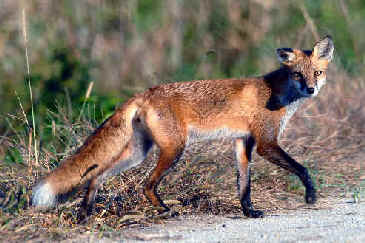
Red Fox
(photo by Howard Eskin)
Gray Fox ______ DE(rare)(*)
MD
NC NJ PA
Urocyon cinereoargenteus
Coyote (ph) ______ DE(*)
MD
NC NJ PA
Canis latrans
Eastern Wolf ______ MD(extirpated)
PA(extirpated)
Canis lycaon
Called the Appalachian Gray Wolf by
Rhoads in 1903.
The Eastern Wolf is now said to be a distinct species, although it has
also been said to be a subspecies of the Gray Wolf or the Red
Wolf. Science has shown that it is closely related to them, but that is
not the same species as either of them.
The Eastern Wolf is a small to medium sized wolf with a light brown
or reddish coat. They also have some longer hairs in their coat that are
usually black. As Eastern Wolves gets older, they develop more of
those long black hairs.
Eastern Wolves are often mistaken for Coyotes due to their
coloring and build.
Well known are the Eastern Wolves in the area of the Algonquin
Provincial Park in Ontario, Canada. They have a large home range. It is
believed that packs of Eastern Wolves follow the movements of White-tailed
Deer, as a way to have plenty to eat, especially in the winter months.
Eastern Wolves are said to be very dependent upon the social aspects
of their pack. They are quite loyal to each other and will do all they can
to keep other packs of wolves out of their territory. That is why they are
often heard howling, so as to publicize and protect their territories.
Eastern Wolves are most active at night but they can also be seen out
during the day.
The Eastern Wolf has a diverse diet. Sometimes animals hunt on their
own, but most of the time they hunt with their pack. Some of their prey when
they hunt alone include rodents, beaver, and muskrat. Prey
when they hunt in their pack includes deer and moose. In some
instances, they have even been able to successfully kill a Black Bear.
The alpha and beta animals mate in February, with the young
born about two months later.
The Eastern Wolf has been known to mate with different types of Coyotes
in their areas. That can definitely affect the overall genetics of the
species (see below the results of a recent study).
It is interesting behavior because otherwise wolves have often been known to
aggressively run off Coyotes, and in the case of the Gray Wolf in
the west, even kill them.
In a recent genetic study, published in May 2011, and adding fuel to a
longstanding debate, it was determined that wolves in the eastern
United States are hybrids of Gray Wolves and Coyotes,
while Coyotes in that region are actually wolf-coyote-dog hybrids.
There were 16 researchers involved in the study from around the globe. It
was said to be the most detailed genetic study of any wild vertebrate
species to date.
The study is not likely to have any impact on the management of the
endangered Red Wolf in North Carolina and the Eastern Wolf in
Ontario, but it offers some fresh insight into their genetic make-up and
concludes that those wolves are hybrids that developed over the last few
hundred years.
On the other hand, some scientists have argued that the Red
Wolf, Canis rufus, and the Eastern Wolf, Canis
lycaon, evolved from an ancient wolf species distinct from
the larger Gray Wolf, Canis lupus, of western North America.
The recent study, referred to above, showed a gradient of hybridization
in wolves, as follows:
In western North America, wolves were pure wolf.
In the western Great Lakes region, they averaged 85 percent wolf and 15
percent Coyote.
Wolves in Algonquin Park in eastern Ontario averaged 58 percent wolf.
The Red Wolf in North Carolina, which as been the subject of
extensive preservation and restoration efforts, was found to be 24
percent wolf and 75 percent coyote.
Coyotes, in the northeastern US, which only colonized in the region
in the past 60 years, were found to be 82 percent coyote, 9
percent dog, and 9 percent wolf.
In a study, last year, museum specimens and genetic samples were used to
show that Coyotes migrating eastward bred with wolves to
evolve into a larger form that has become the top predator in the Northeast
US, filling a niche left when native eastern wolves were hunted out
of existence. This hybridization allowed Coyotes to evolve from the
smaller mouse-eater of western grasslands to a larger deer-hunter in eastern
forest.
Still a question is how it is that Gray Wolves don't typically breed
with Coyotes, but kill them. In the West, wolves don't
hybridize with Coyotes, even in the circumstance when single wolves
looking for mates have dispersed into the middle of "Coyote
country".
Red Wolf (i) ______ NC(*)
Canis rufus
Some say that the Red Wolf is a "historical hybrid" between the
Gray
Wolf, Canis lupus, and the Coyote,
Canis latrans. It was introduced into eastern North Carolina from the
Southwest US.
7 Red Wolves
were seen during a FONT North Carolina tour, early one morning, in August
1998.
Arctic Fox ______
Alopex lagopus
Bears
American Black Bear (ph) ______
MD NC(*) NJ PA
Urus americanus
Called the East American Black
Bear by Rhoads in 1903.
Black Bears were seen
during nearly all land-birding excursions during FONT tours west of Manteo in August 1997,
1998,
& 1999. With usually more than one bear per outing. They were seen on
dirt roads and "surfing" in nearby fields of soy beans.
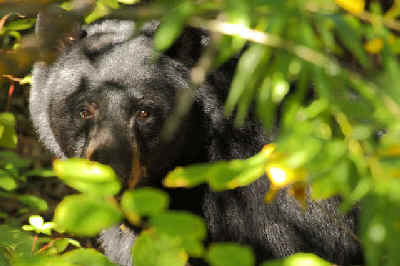
American Black Bear
(photo by Peter Burke)
Polar Bear ______
Ursus maritimus
Raccoon and
Mustelids
Northern Raccoon (ph) ______
DE MD NC NJ PA VA(*)
Procyon lotor
The Northern Raccoon, or "Coon" as it
was also called by Rhoads in 1903, was described by Linnaeus in 1758.
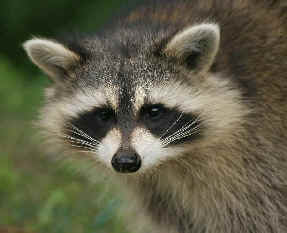
Northern Raccoon
(photo by Doris Potter)
Northern River Otter ______
DE(*) MD NC NJ(*) PA(rare)
Lontra canadensis
American Mink (ph) ______
DE MD NC NJ(*) PA
Mustela vison
In 1903, Rhoads gave the
scientific name of the American Mink as Putorius
vison, with the nominate subspecies being the Northeastern
Mink, and Putorius vison lutreocephalus
being the Southeastern Mink.

American Mink
(photo by
Howard Eskin)
American Marten ______
PA(extirpated)
Martes americana
Also called the American Sable by Rhoads in 1903.
Fisher ______ MD
PA
Martes pennanti
Also called the Pennant's Marten, or the Pekan, by Rhoads
in 1903.
The Fisher has been re-introduced in Pennsylvania.
Wolverine ______ PA(extirpated)
(now
extirpated in the northeastern US)
Gula gula
Also called the Glutton, or Carcajou, by Rhoads in 1903.
The species was described by Linnaeus in 1766, when it was said by him to be
in the genus Ursus, that of the bears.
Rhoads (in 1903) stated that the Wolverine was the rarest animal in
Pennsylvania in the early 1800s, when it was only found in the most boreal
localities in that state as a straggler.
The type locality was by Hudson Bay in Canada. Today, in eastern North
America, the species is only found in northern Canada. It has generally been
in the Hudsonian and Canadian Zones, but historically it been found as far
south as Pennsylvania and Colorado.
Ermine ______
MD NJ PA (in
Europe, also called the Stoat; the species is widespread
throughout the Northern Hemisphere)
Mustela erminea
Called the Short-tailed Weasel, or the Bonaparte's Weasel,
by Rhoads in 1903, with the scientific name Putorius
cicognani.
When describing it (in North America), in 1838, by Charles Lucien Jules
Laurent Bonaparte (the nephew of Napoleon Bonaparte) gave it the scientific
name Mustela cicognani. Charles
Bonaparte (minus his other 3 names) lived in New Jersey, near Philadelphia
(the location of the Academy of Natural Sciences).
Least Weasel ______ MD(rare)
NC PA(rare)
Mustela nivalis
Called the Alleghenian Least Weasel by Rhoads in 1903, when he
noted that the species was described in Washington County, Pennsylvania in
1900, and was given the scientific name Putorius
allegheniensis.
Long-tailed Weasel ______
DE(*) MD NC NJ PA
Mustela frenata
Also called the New York Weasel, or the Common Weasel, by
Rhoads in 1903, with the scientific name Putorius
noveboracensis.
Eastern Spotted Skunk ______
MD(very rare) NC PA(rare)
Spilogale putorius
Striped Skunk (ph) ______ DE(*)
MD
NC NJ PA
Mephitis mephitis
Called the Southeastern Skunk by Rhoads in 1903, referring to
Mephitis mephitis putida.
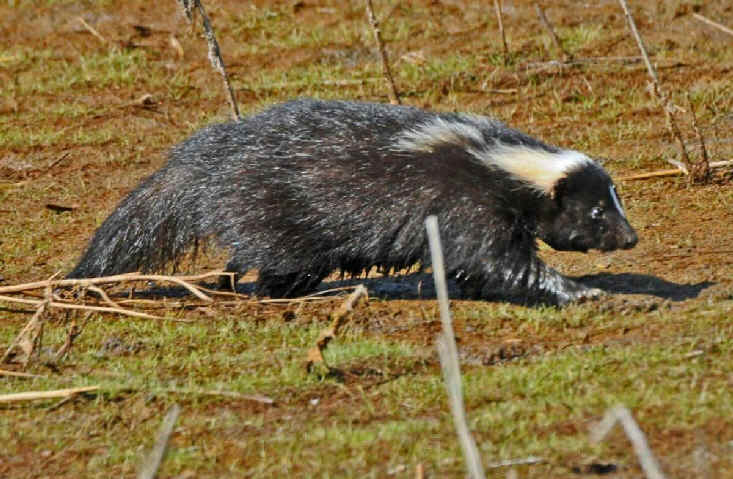
Striped Skunk
(photo by Howard Eskin)
Seals
Harbor Seal (ph) ______
DE(*) MD NJ VA(*)
Phoca vitulina
Also referred to as the "Sea Dog" by Rhoads in 1903. The
species was described by Linnaeus in 1758.
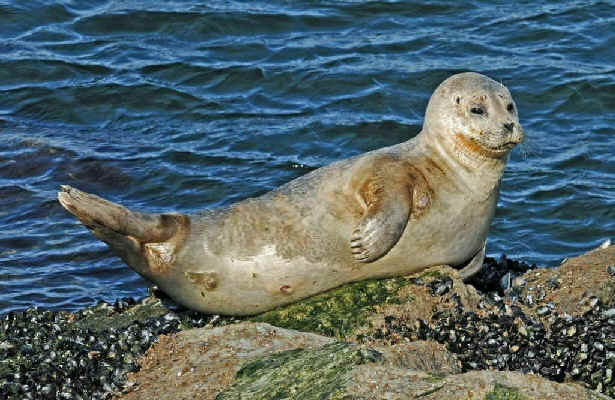
Above & below: Harbor Seals
(photo by Howard Eskin)
Below, a sequence of 3 photographs taken in New Jersey in January 2015
(same seal, same photographer: Howard Eskin)

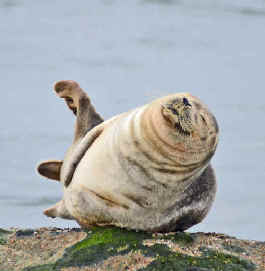
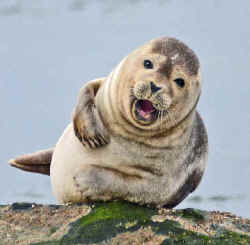
Harp Seal ______ NJ(very
rare)
Phoca greenlandica
Hooded Seal ______
NJ(very rare)
Cystophora cristata
Also called Bladdernose by Rhoads in 1903.
Gray Seal ______
MD(very rare) NJ(very rare)
Halichoerus grypus
A Gray Seal was photographed on a jetty in Ocean City, Maryland
on May 14, 2011. The species is said to be expanding its range south.
Caribbean Monk Seal ______
(now
extinct, formerly occurred in Florida)
Monachus tropicalis
Deer
White-tailed Deer (ph) ______
DE(*) MD(*) NC(*) NJ(*) PA(*)
VA(*)
Odocoileus virginianus
Called the Virginia Deer by Rhoads in
1903, when it was Odocoileus americanus.
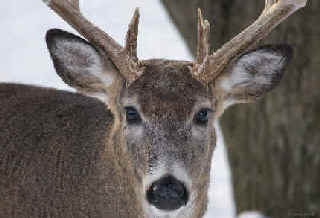
White-tailed Deer
(photo by Howard Eskin)
Moose (ph) ______ PA(extirpated)
Alces alces

A Moose photographed during a FONT tour
Elk (ph) ______ PA(reintroduced)
Cervus elaphus
Called the Eastern Wapiti, or Elk, by Rhoads in
1903, when it was Cervus canadensis.
Elk were once numerous in Pennsylvania up to the beginning of the 19th
Century in the entire Alleghenian mountain system east of the Allegheny
River. They were rare in the state in the Blue Ridge and Cumberland Ranges,
and they were once common on the Pocono Plateau. By the end the 19th
Century, they were extirpated in Pennsylvania, primarily due to
over-hunting.
Elk occur in northwestern Pennsylvania now. They are descendents of
Rocky Mountain animals that the Pennsylvania Game Commission brought in
between 1913 and 1926.
The current-day range of the Elk in Pennsylvania is believed to
extend into parts of Elk, Cameron, McKean, Potter, Clinton, Centre, and
Clearfield Counties, with the central point of the herd being in Elk County
(appropriately), and specifically near Benezette.
The population now in Pennsylvania probably numbers slightly more than 500.
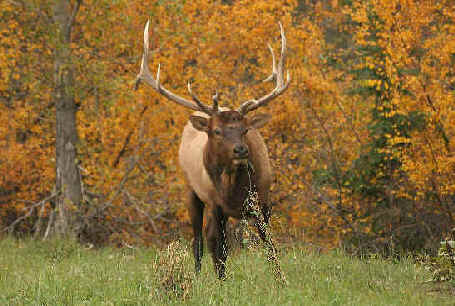
Elk
(photo by Doris Potter)
Sika Deer (i) (ph) ______ MD
VA(*)
Cervus nippon
Sika Deer were introduced on Assateague Island in Maryland in the 1920s.
It is now locally common elsewhere on the Lower Eastern Shore of Maryland,
especially in Dorchester County.
Caribou (ph) ______
Rangifer tarandus
Bison
American Bison ______
PA(extirpated)
(now extinct in eastern North America)
Bison
bison
Called the Buffalo, or American
Bison, by Rhoads in 1903. The species was described by Linnaeus in
1758.
In the 1903 book by Rhoads:
"The American Bison was once normally found in Pennsylvania in
the valleys and mountain glades of the Ohio, Monongahela, and Allegheny
Rivers, whence it passed sparingly eastward across the Allegheny passes into
the tributary valleys of the Susquehanna, thence reaching the Delaware
Valley as only a straggler."
In 1903, there were the words "whence" and "thence".
Manatee
West Indian Manatee (ph) ______
MD(very rare) FL
Trichechus manatus
The West Indian Manatee in eastern North America is normally in
Florida.
Occasionally, it is found further north, as when one was in Calvert County,
Maryland on July 15, 2011 at the St. Leonard Marina.
A West Indian Manatee (but assumed to be from Florida) was seen
in Delaware on July 23, 2015, in the Chesapeake and Delaware Canal. That
canal, in northern Delaware, connects the Chesapeake and Delaware Bays.
About 2 weeks earlier, a manatee (either the same or another) was
reported in the Chesapeake Bay in
Maryland.
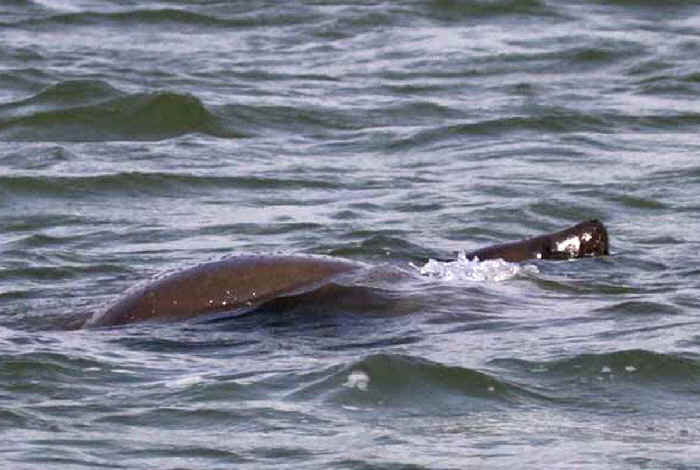
A West Indian Manatee photographed during a FONT
tour
(photo by Marie Gardner)
Marine Mammals:
Whales,
Dolphins, and Porpoise
- Gray Whale ______ (now
extinct in the Atlantic Ocean)
Eschrichtius robustus
The Gray Whales that formerly occurred in the North Atlantic
Ocean were hunted to extinction by the 17th or 18th Century.
- North Atlantic Right Whale (p) (ph) ______ MD(rare)
NJ(rare)(*)
Balaena (or Enbalaena) glacialis
Called the Black Right Whale by Rhoads in 1903.
In the 1903 book by Rhoads, this account was written in 1865:
"The Right Whale was formerly abundant about the mouth of
the Delaware River. A letter of William Penn dated 1683 states that 11 were
taken that year about the Capes (May & Henlopen)."
The type specimen of Cope's Balaena
cisarctica, now considered a synonym of Balaena
glacialis, was taken in 1862 in the Delaware River opposite
Philadelphia. The skeleton was mounted in the museum of the Academy of
Natural Sciences in Philadelphia.
The North Atlantic Right Whale is today a rare creature, but the following
was already written in 1903:
"Once abundant in the North Atlantic. Recently, nearing
extinction."
Fortunately, the whale, though rare, still survives.
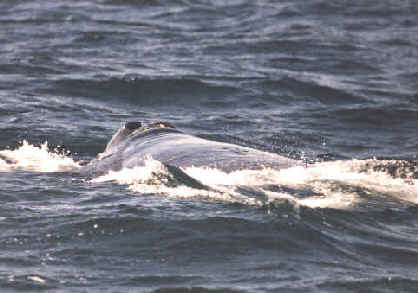
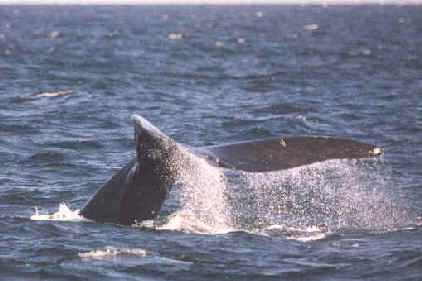
Two photos of the rare & endangered North Atlantic Right Whale
- Great Sperm Whale (p) (ph) ______
MD(rare) NC(*)
NJ(rare)
Physeter catodon
Called the Sperm Whale or Cachalot
by Rhoads in 1903. The species was described by Linnaeus in 1758.
Great Sperm Whales were seen during
FONT North Carolina pelagic trips in
May & August 1998 with calves. At times close to the boat.
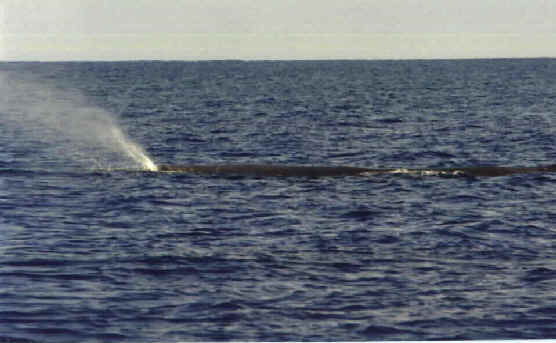
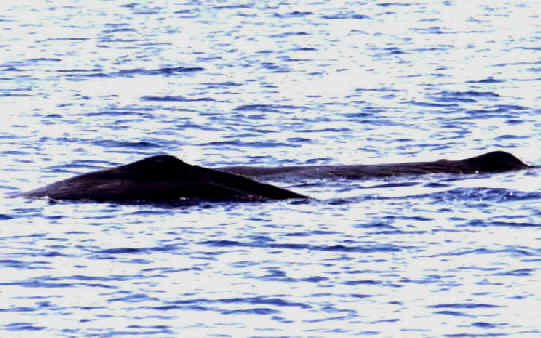
2 photos of Great Sperm Whales, as seen during FONT pelagic trips
off the North Carolina Coast
- Dwarf Sperm Whale (ph) ______
MD(rare) NJ
Kogia simus
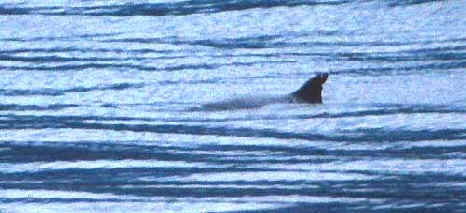
A Dwarf Sperm Whale photographed during a FONT tour in the Caribbean.
- Pygmy Sperm Whale (ph) ______
MD(rare) NJ
Kogia breviceps
Called Pigmy Sperm Whale by Rhoads in 1903.
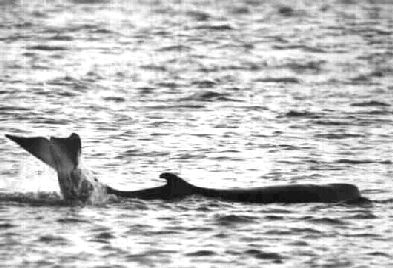
Pygmy Sperm Whale
(photo courtesy of Alan Brady)
- Humpback Whale (p) (ph) ______
MD(rare)
NJ(rare)(*)
Megaptera novacangliae
Called the New England Humpback Whale by Rhoads in 1903.
The following, about the Humpback Whale, is from the book by Rhoads that
same year:
""Owing to the poor quality of this whale, it is avoided by
whalers. It is distinguished from the Rorqual (the Fin Whale)
by the great length and size of its fins.
The hump-like form of the dorsal fin gives it the common name.
They are extremely variable in color, with black, white, and gray being
variously combined.
The Megapteras (Humpbacks) are the only baleen whales that
"breach" or leap clear of the water. They are very playful,
striking each other resounding whacks with their immense flippers and
thrashing about in and out of the water so as to be heard miles away in
favorable weather.
They have been known to spout twenty feet high in calm weather.
The young number one to two.
They feed on crustaceans and fish."
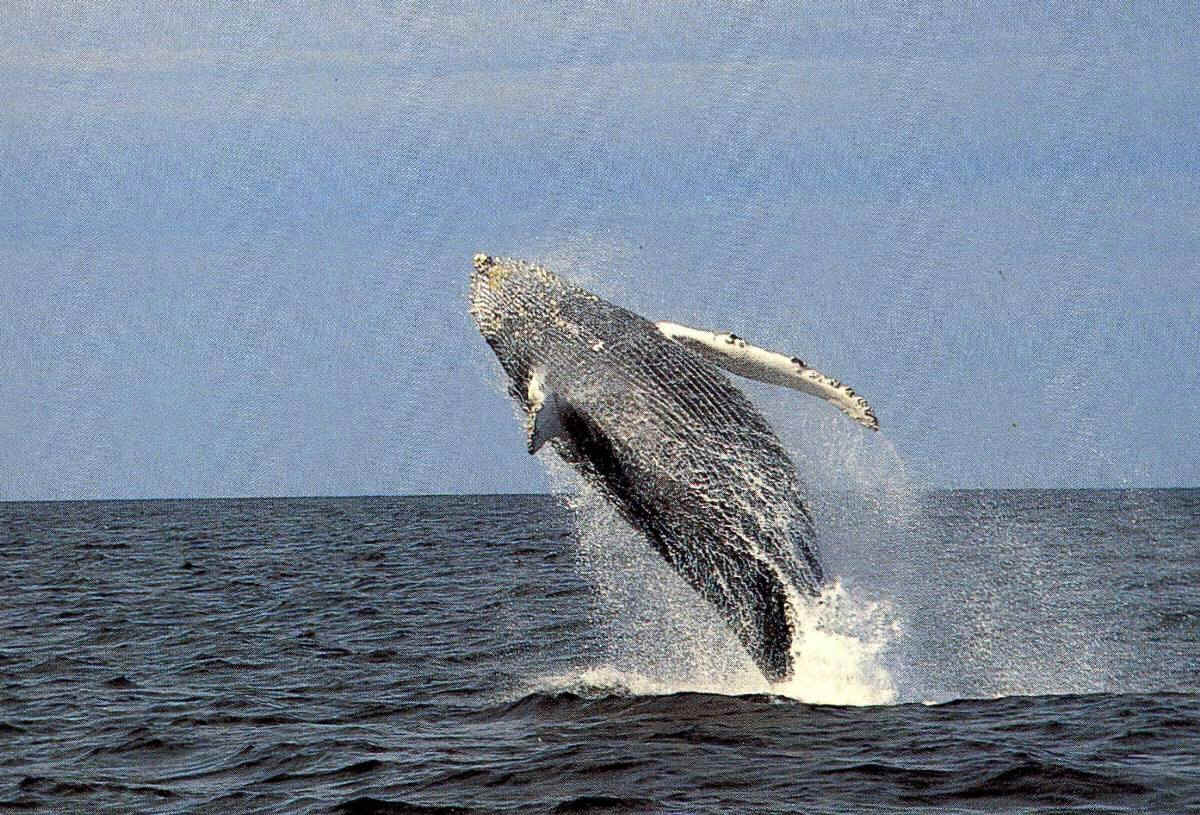
Above: a Humpback Whale breaching
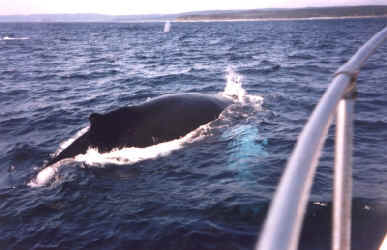
Above: a Humpback Whale by the boat, during a FONT tour
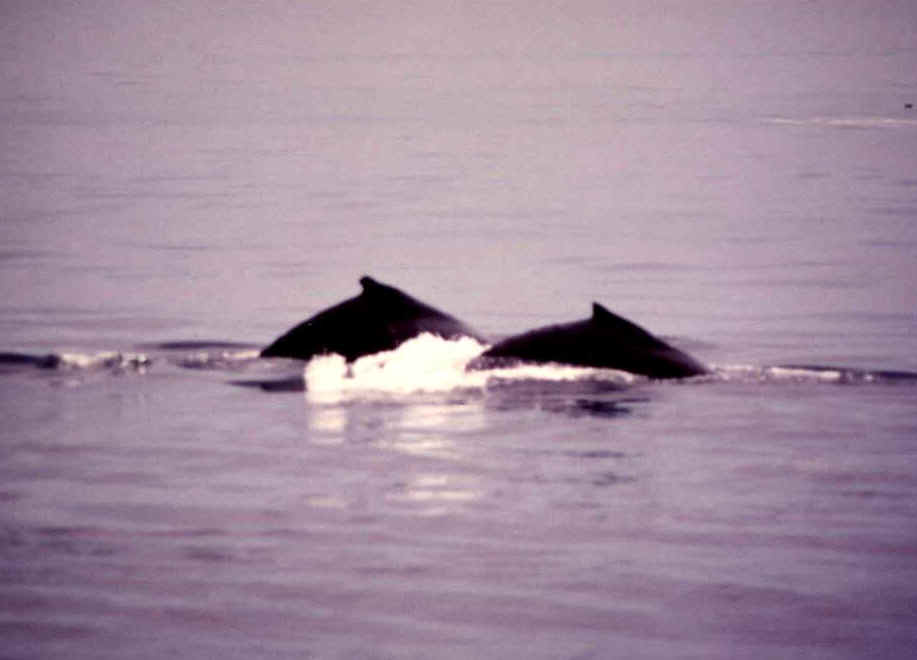
Above: 2 Humpback Whales, with their humped backs
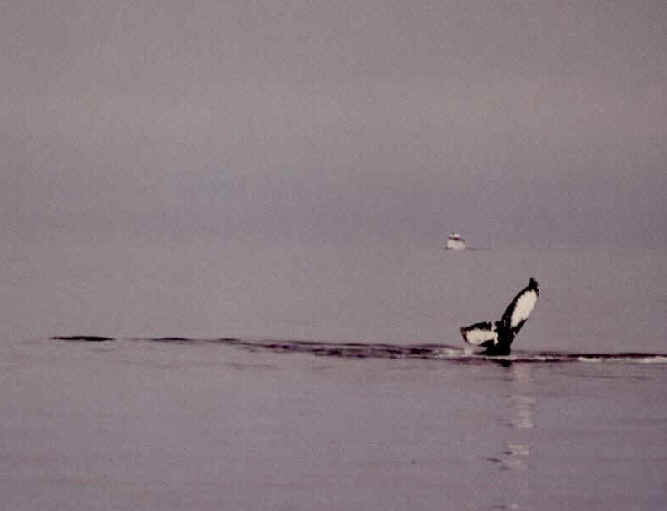
Above & below: Tails of Humpback Whales
(photographs by Armas Hill)
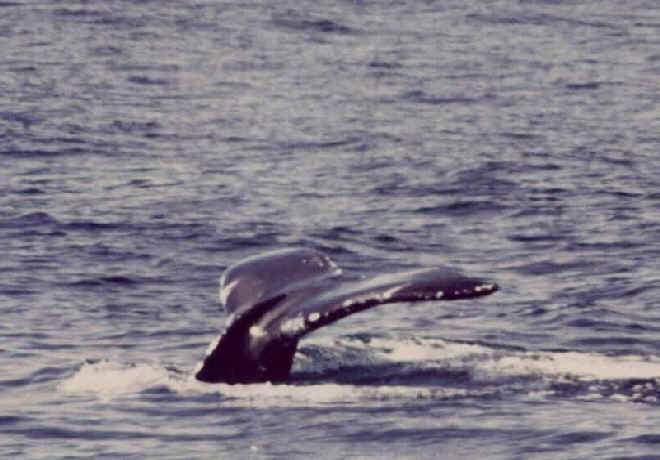
- Blue Whale (ph) ______ MD(rare)
NJ(rare)
Balaenoptera musculus
Called the Great Blue Whale by Rhoads in 1903. The species was
described by Linnaeus in 1758.
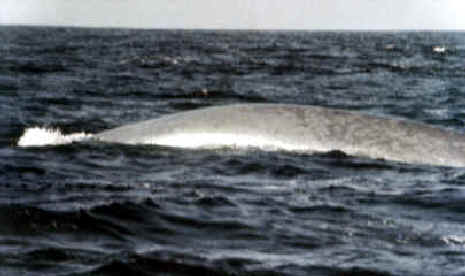
Blue Whale
(photo by Armas Hill)
- Fin Whale (p) (ph) ______
DE(rare)(*) MD(rare)(*) NC(*) NJ(rare)(*)
Balaenoptera physalus
Called the Great Finback by Rhoads in 1903. This species was
described by Linnaeus in 1758.
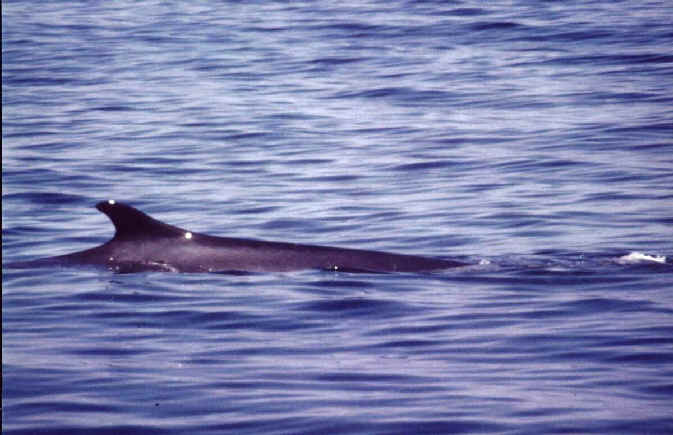

Two photos of Fin Whales during a FONT pelagic trips
off the coast of eastern North America
- Northern Minke Whale (p) (ph) ______
MD NC NJ(*)
Balaenoptera acutorostrata
Called Little Piked Whale by Rhoads in 1903.
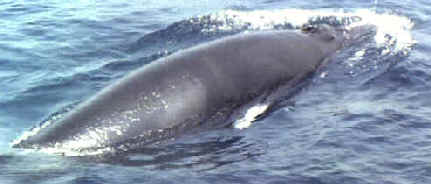
A Northern Minke Whale photographed during a FONT pelagic trip
- Bryde's Whale ______
Balaenoptera edeni
- Sei Whale ______ MD(rare)
NJ(rare)
Balaenoptera borealis
- Cuvier's Beaked Whale (p) (ph) ______
MD NC(*) NJ
(another name is Goose-beaked Whale)
Ziphius cavirostris
Cumulatively, during 3 August 1998 FONT
North Carolina pelagic trips, 9 Cuvier's
Beaked Whales were seen.
During FONT North Carolina pelagic trips
in May 1999, 3 species of beaked whales
were seen: Cuvier's, Blainville's, and True's.
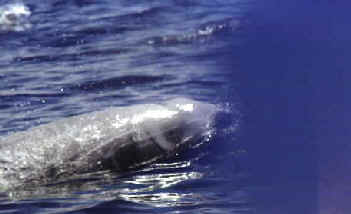
Cuvier's Beaked Whale
- Blainville's Beaked Whale (p) ______
NC(*) NJ (another name is
Dense Beaked Whale)
Mesoplodon
densirostris
- True's Beaked Whale (p) ______
MD NC(*) NJ
Mesoplodon mirus
mesoplodon
- Sowerby's Beaked Whale ______
Mesoplodon bidens
- Gervais' Beaked Whale ______ NJ
Mesoplodon europaeus
- Northern Bottlenose Whale ______
Hyperoodon ampullatus
- False Killer Whale (p) ______ NC(*)
Pseudorca crassidens
6 False Killer Whales
were seen at sea during a FONT North Carolina pelagic trip in June 1996.
- Pygmy Killer Whale ______
Feresa attenuata
- Killer Whale (or Orca) (ph)
______ MD(very
rare) NJ(rare)
Orcinus orca
Called the White-bellied Killer by Rhoads in 1903. The species
was described by Linnaeus in 1758.
- Melon-headed Whale ______ MD
Peponocephala electra
- Gray Grampus (or Risso's Dolphin) (p) (ph)
______ MD NC NJ(*)
Grampus griseus
Called the Grampus, or Cow
Fish, by Rhoads in 1903.

Gray Grampus
(or Risso's Dolphin)
- Beluga ______ NJ(very
rare)(*)
Delphinapterus leucas
A single Beluga was in the Delaware River (between
Pennsylvania & New Jersey) in April 2005. It traveled as far
north in the river as the fall line at Trenton.
The Beluga, named "Helis" by NOAA (the National
Oceanic & Atmospheric Administration), was from the Saint Lawrence River
Beluga population in eastern Canada, He spent the week of April 11 in the
river between Trenton and Philadelphia, before heading south. He was seen in
the middle of the Delaware Bay on April 18.
"Helis" was said to be an old Beluga, somewhere
around 27 to 30 years of age.
- (Short-beaked) Common Dolphin (p) (ph)
______ MD NC(*) NJ(*) (another
name has been Saddle-backed Dolphin)
Delphinus delphis
This species was described by Linnaeus in 1758.
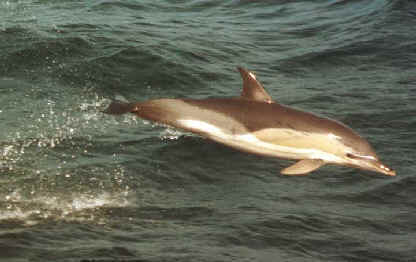
A Common Dolphin during a FONT pelagic trip
(photo by Andy Smith)
- Common Bottlenose Dolphin (p) (ph) ______
MDE(*) MD(*) NC(*) NJ(*)
Tursiops truncatus
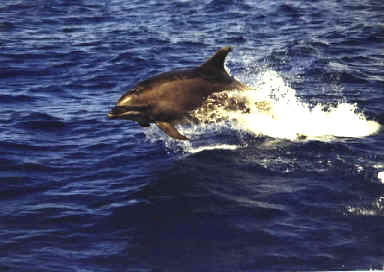
A Common Bottlenose Dolphin during a FONT pelagic trip
- Atlantic Spotted Dolphin (p) ______
MD NC(*) NJ
Stenella frontalis (has also been Stenella
plagiodon)
- Pantropical Spotted Dolphin ______
Stenella attenuata
- Spinner Dolphin ______
Stenella longirostris
- Clymene (or Short-snouted
Spinner) Dolphin (p) (ph) ______ NC(*)
Stenella clymene
Clymene (or Short-snouted Spinner) Dolphins, during the August
10, 1998 FONT pelagic trip, were said to
be the first for
North Carolina offshore waters.
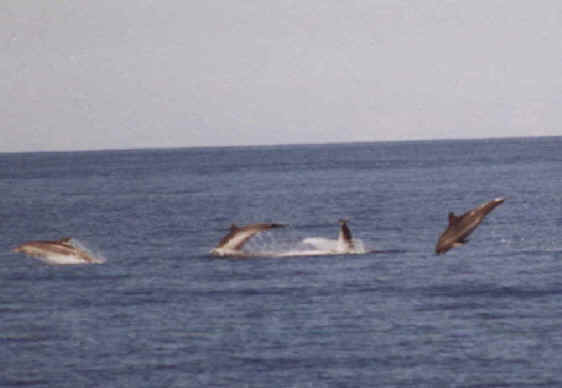
Clymene Dolphins during a FONT pelagic trip
offshore from the coast of North Carolina
- Striped Dolphin ______ MD
NJ
Stenella coeruleoalba
- Rough-toothed Dolphin ______
Steno bredanensis
- Atlantic White-sided Dolphin ______ MD NJ(*)
Lagenorhynchus acutus
- White-beaked Dolphin ______
Lagenorhynchus albirostris
- Short-finned Pilot Whale (p) ______
MD NC(*) NJ(*)
Globicephala macrorhynchus
Called the Southern Blackfish
by Rhoads in 1903, when it was Globicephala brachyptera.

Short-finned Pilot Whales during a FONT pelagic
trip
- Long-finned Pilot Whale (p) (ph)
______
MD NJ(*)
Globicephala melas
Called the Northern Blackfish by Rhoads in 1903.
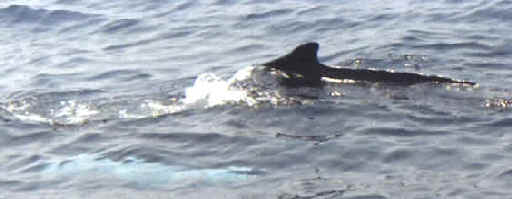
A Long-finned Pilot Whale during a FONT pelagic
trip
- Harbor Porpoise ______ MD(rare)
NJ(rare)
Phocoena phocoena
Called the Harbor Porpoise, or Herring Hog, by Rhoads in
1903. The species was described by Linnaeus in 1758.
Reference for the above mammal lists includes the book: "Mammals of North America" by Roland W.
Kays & Don E. Wilson, published by Princeton Univ Press, 2002.
Also "The Encyclopedia of Mammals" edited by Dr. Donald Macdonald,
updated in 2006
To Top of Page


 MAMMALS
MAMMALS![]()




















































